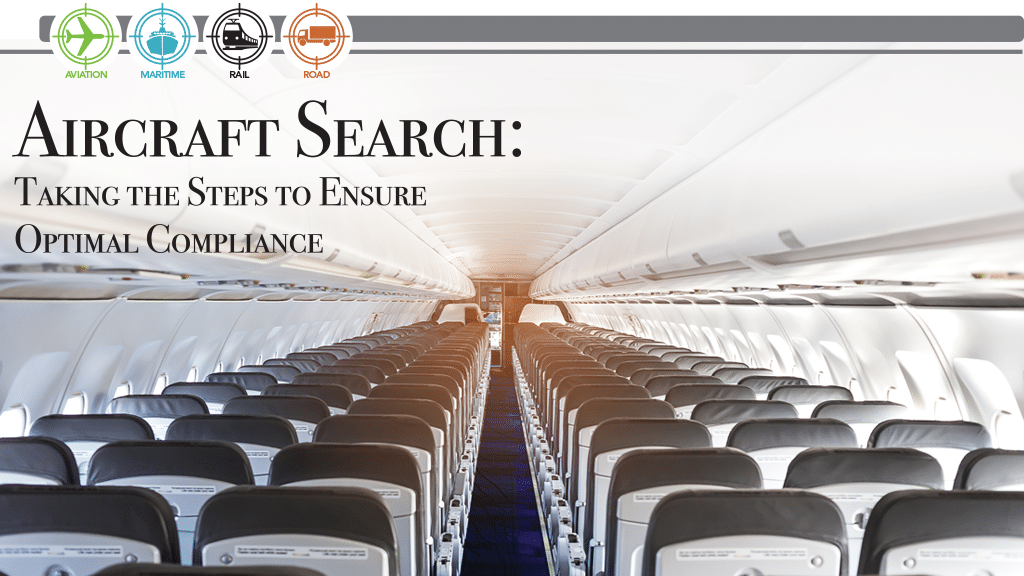The aviation industry had a tough dig out of the Covid-19 pandemic hole, but now, airports and airlines appear to be back booming with full passenger loads and enough construction to last a lifetime. Much of the focus over the 2021-2022 rebuilding period was on staffing level. Aviation employers could not seem to get qualified personnel through the doors, trained up, and out into operations quick enough. There was a real lack of operational grasp and disengagement in security culture. Thankfully, as an industry, we all got “back to basics” to re-energize the culture and refine the fundamentals to an accepted level of compliance.
Aircraft Search: Daily Challenges and Best Practice Review
The topic of aircraft cabin search remains relevant and ever evolving. In October 2020, I had the privilege to write a piece (for what was then ASI Magazine) examining aircraft cabin search and the daily challenges and best practice to reduce inconsistency and make the operation as effective as possible. Fast forward three-plus years, it is important as security practitioners that we revisit the foundational concepts that build out our security programs with the intent of continuous improvement. Plus, with today’s threat landscape across the globe, aviation (and all critical infrastructure and security sectors for that matter) will continue to be a high target for attack.
As a little bit of back story, my previously published article from 2020 outlined several of the daily challenges security organizations and stakeholders faced with aircraft cabin search operations. These included delivery of effective training (specific training for various aircraft cabin configurations plus adapting to your demographic and audience), the stress of a highly regulated environment, poor utilization of equipment, lack of management and operational pressure. To tackle many of these challenges, there are basic steps an organization can apply for oversight measures. Or possibly look at a larger strategy adjustment to achieve a more consistent operation and higher level of performance.
Unfortunately, our world continues to be faced with emerging threats and ongoing conflict. And the trouble is not siloed to physical incidents. Multiple industries are now seeing a large uptick in cyber crime as well; so, protecting and checking for data accuracy also needs to become top of mind.
This article is broken down into multiple sections. Each section briefly discusses a stakeholder’s perspective and approach to achieve optimal compliance in aircraft cabin search.

The Airline’s Perspective
There has been a drastic change on the airline side and their view of security. In past years, security was a pesky cost added and required on a station’s P&Ls, but now it is prioritized and planned into the daily operations. The concept of CPTED (crime prevention through environmental design) has become more prevalent these days when approaching integration of security.
As an airline that’s placed security as a top priority for a very long time, Virgin Atlantic has taken some further steps to ensure compliance. In a recent conversation with Gareth Cross, AVSEC manager: regulations and compliance for Virgin Atlantic’s Corporate Security Department, he stated that the organization shifted to a risk resiliency and SeMS approach to security. Now, as part of a proactive measure, the Corporate Security is seen as a consultant and partners with the engineering group during the design phase of aircraft and collaborates in the decision-making process to ensure compliance with the company’s security program, as well as the multitude of civil aviation regulations and Transportation Security Administration (TSA) programs.
Let’s examine the life vests on an aircraft. Here in the United States, the TSA requires foreign carriers to either seal their life vest compartments, which then requires the security provider to inspect the seals for any evidence of tampering. Otherwise, each individual life vest must be removed from the pouch or compartment and thoroughly inspected for prohibited items. Some of the newer life vest technology that is being utilized by many airlines does not quite meet some standards. Although sealed, the design still allows for the concealment of small, prohibited items. In addition, the way some life vest compartments are affixed underneath the seat allows for more potential concealment space, and the location is difficult to spot for the security team. Doing the proper research and selecting the appropriate life vest compartment design will reduce the vulnerability and have a direct impact on compliance.
The Security Provider Perspective
Security companies continue to be faced with ongoing challenges, so it is critical that an organization places heavy emphasis on a strong security culture to mitigate risk. Within the framework of security culture, we can typically break it down into three functional areas: people, processes, and technology. If the fundamentals of aircraft search have been established, then further assessment of the functional areas will allow a security provider to put focus on continuous improvement. First, let’s cover refining processes within quality control, then discuss where technology fits into the equation.
For quality control processes, routine testing is a solid best practice. If you are looking to achieve the highest level of effectiveness from the company’s covert testing program, it’s essential to think about the approach and methodology towards covert testing, otherwise you may end up with a false sense of security. In other words, just conducting covert tests is not sufficient; the planning, execution, and follow up is critical.
There are a few considerations that should be applied towards the covert testing methodology:
• Types of test pieces being utilized.
• Placement of the test piece and accountability.
• Who was involved during the test.
• Documentation and reporting.
Starting with test pieces, the approach here needs to be a holistic one. More often than not, security officers have fallen into a complacent pattern of searching for a specific test item. If a company is constantly testing the team using this one specific item, the daily routine has now become search an aircraft for the “orange ball.” The search mindset needs to change to item recognition. It is not about looking for the “orange ball”; the mission must shift towards what item does not belong on the aircraft. As we all know, threat items can be disguised as anything!
Selecting the test pieces for a covert testing program is a very sensitive area that requires careful consideration and collaboration for multiple stakeholders. One popular opinion is to utilize lifelike test pieces that will require a heightened level of vigilance from security officers. The upside to this strategy provides more of a real-world simulation, raising the performance bar for compliance, but the risk level for potential lack of accountability becomes severe. If a test piece goes missing and is potentially found while in-flight, a disruption to operations will come at a very high cost to an air carrier. It’s recommended that any sensitive test pieces be approved by the specific air carrier, and loop in your regulatory partners.
The execution of a covert test requires planning. It is important the security providers are familiar with the aircraft configuration and conduct tests in multiple areas. Repetitive test piece placements will ultimately result in a false sense of security and lead to complacency among the security team.
The last component here for covert testing is the emphasis on documentation and effective reporting. Putting the mechanisms in place to gather a wide range of data will prove invaluable when the shift to proactive mitigation is put into place. If an organization has the capability to track the trends of who located or missed a test piece, where it was placed, the type of aircraft, what type of item was used, now more effective decisions can be made going forward on operational procedures. Could failures be due to a gap in the training program? Does the current SOP not require a specific area to be searched? Is a change needed in the staffing plan? These factors can now all be data-driven decisions.
Aside from the covert testing, another key layer of quality control involves paperwork review, and verifying people versus time. And what this boils down to is the accuracy of data. This is the area where technology can play a pivotal role.
An effective aircraft cabin search is going to average a certain amount of time, with a designated amount of security officers assigned to the task. Conducting frequent reviews of the flight turnaround data will help to ensure a level of consistent service is maintained. If there are any anomalies, those instances will need to be investigated. For example, if on a given day two security officers search an entire widebody aircraft in 30 minutes which usually takes a staff of eight officers, that needs to be marked as a red flag and investigated. Currently, there is proven technology out in the market that can be utilized to track and trace airport personnel movements. Having a platform such as this in place provides that layer of transparency for auditing operations in real time.
The Regulatory Perspective
Aviation security regulators remain focused and vigilant on keeping the traveling public safe. And the same core mission applies to all transport sectors — including maritime, railroad, bridges and roadways. Here in the U.S., the TSA will continue to utilize their intelligence to prepare for emerging threats.
It is important to remember that security regulators and inspectors are on our team. The purpose of any government and/or civil aviation authority audits are to ensure all stakeholders are maintaining an acceptable level of compliance based on a determined threat level. They are not out for the “we got you” mentality. The goal is to establish the assurance that aviation is operating at an optimal level of public safety (this includes the aviation workers as well).
The best way to develop a solid working relationship with the regulatory entities is through communication. Set up a regular meeting cadence. Topics on the table for discussion can include local and foreign concerns, joint-testing and audits, best practices, and clarifying any unclear regulatory guidelines. Having this type of relationship and open dialogue in place between stakeholders will have a direct positive impact on compliance and culture within the security scope.
About the Author
Douglas O’Mara is based in New York and works for Global Elite Group, the U.S. aviation security division of Securitas Transport Aviation Security. He is senior vice president of performance and regulatory compliance, with focused oversight of company AVSEC training, quality control, safety, and regulatory. Doug is an ICAO AVSEC PM and Airport Certified Employee – Security (American Association of Airport Executives). He can be contacted at domara@globaleliteinc.com.
